Modern Masonry Using Pre-blended Mortar
Blending and certification in the factory overcomes field mix uncertainties
![]() Continuing Education
Continuing Education
Use the following learning objectives to focus your study while reading this month’s Continuing Education article.
Learning Objectives - After reading this article, you will be able to:
- Identify the durability and performance impacts of mortar in a masonry wall and the ingredients that define its makeup and attributes.
- Investigate the differences in various types of mortar and the standards that apply to them.
- Compare the differences between site-mixed and pre-blended masonry mortar.
- Specify pre-blended mortar for a variety of buildings and with appropriate selections related to specific applications.
The use of mortar is a process that has changed little since the days of ancient Greece. Unlike lumber, steel, and other building materials found on today’s construction sites, mortar ingredients are typically brought individually onto the site and stored where the masonry work is being done. Then they are shoveled into some form of mixer (manual or powered) to combine the dry ingredients along with a measured quantity of water. The results have been quite understandably dependent on the quality of the ingredients used, the skills of the people doing the portioning and mixing, and the outdoor environmental conditions—all variables that can and have produced quite variable outcomes in terms of mortar quality and performance. In our current time, there are some well-documented conditions that also come into play. Shortages of skilled construction labor means that it is uncertain how precisely the mortar is being mixed on-site. At the same time, manufacturers have made substantial strides in bringing modern production techniques to mortar by employing computerized technology that allows great precision in many factory settings. Therefore, rather than trusting the production process to hand mixing in unpredictable conditions, factory pre-blended mortar is becoming more and more the preferred norm for masonry construction of all types. Architects, engineers, contractors, and building owners are realizing that pre-blended mortar eliminates many of the variables and uncertainties of site-mixed mortar, thus reducing the potential for problems and liability with the finished masonry construction. In this course, we will look at the types of mortar available, the process and pitfalls of field mixing versus pre-blended mortar, and the significance of mortar in masonry assemblies.
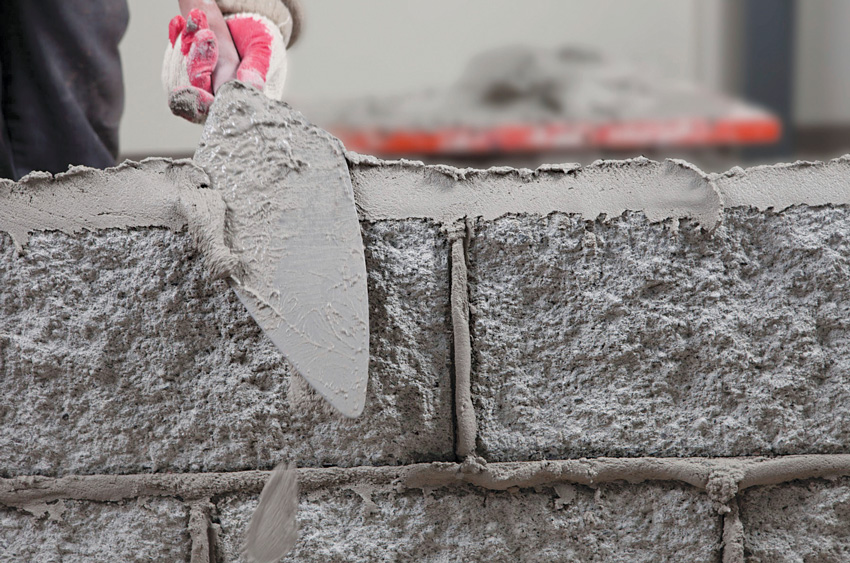
All images courtesy of Echelon Masonry by Oldcastle
Masonry mortar is critical to the integrity and performance of masonry construction. The use of pre-blended mortar creates a much more highly controlled mixture of ingredients to help assure that the desired results are achieved.
Mortar Standards
Given the variability in the ingredient choices, how can we be sure that the ultimate mortar mix is proper and appropriate for use on a particular building? To address that, there are two different ASTM standards that are available—essentially one for site-mixed mortar and one for pre-blended mortar. ASTM International provides objective, consistent testing and specification protocols that are relied on across the construction industry to establish a benchmark for materials. By referencing and understanding the relevant ASTM standards for mortar, architects can write specifications based on these industry standards that help streamline construction and provide a basis for quality control. Therefore, each of the two ASTM standards for mortar are discussed further as follows.
ASTM C270: Standard Specification for Mortar for Unit Masonry
This is the standard specification that covers mortars mixed together for use in the construction of non-reinforced and reinforced unit masonry structures. It applies directly to site-mixed mortars and is also referenced in the specification for pre-blended mortars. The specification offers two different paths to comply. The first is a proportion specification that identifies the relevant proportion of each identified ingredient of a mortar mix to the other ingredients. It is easy to see why this is popularly and commonly used on construction sites since measuring quantities of ingredients are the easiest to accommodate with on-site labor. The second option is to follow a property specification that is based on specific properties of the mortar and necessarily requires testing to confirm that those properties are met. However, this standard is not a specification to determine mortar strengths through field testing. That is handled separately under ASTM C780 16a: Standard Test Method for Preconstruction and Construction Evaluation of Mortars for Plain and Reinforced Unit Masonry.

ASTM standards have been developed to provide a basis for the formulation and strength characteristics of both site-mixed and pre-blended mortar.
ASTM C1714: Standard Specification for Pre-blended Dry Mortar Mix for Unit Masonry
The cement and mortar industry began addressing some of the inherent issues of the number of variables in mortar and cement types by creating pre-blended dry mixes of cement, lime, and sand, plus admixtures where appropriate, in a controlled factory environment. The pre-blended products were then packaged in large sacks or in bulk and delivered to job-sites. By the early 2000s this pre-blended alternative to site-blended mortars had been growing in use to the point that it began to account for the majority of masonry mortar applications.
In the years just prior to 2009, ASTM International and the Committee C12 on Mortars and Grouts for Unit Masonry recognized this growing use of pre-blended dry mortar, which was following the requirements of ASTM C270. However, certain aspects of using pre-blended dry mortar are not covered by ASTM C270, such as factory testing, packaging, and confirmation of the ingredients used. As a result, a new standard was developed by ASTM International to address issues specifically related to pre-blended dry mortar designated ASTM C1714/C1714M: Specification for Pre-blended Dry Mortar Mix for Unit Masonry.
This standard, while separate from ASTM C270, covers masonry mortars whose materials and design requirements are still governed by the C270 specifications but, instead of being produced from individual raw materials delivered to the job-site, they are pre-blended dry in a factory. This standard specifically addresses the issues of field sampling, testing, directly comparable test results, packaging, and the traceability of ingredients of pre-blended dry mortar mix. The tight control of ingredient ratios possible with pre-blended dry mortar is also covered. Overall, there are five main components to ASTM C1714: 1) traceability of mortar mix ingredients; 2) ingredient blending consistency; 3) testing frequency; 4) allowance of additives based on performance; and 5) dryness of all included ingredients. In addition, ASTM C1714 provides guidance on the use of admixtures that is specific to pre-blended dry mortar and not included in ASTMC270 or ASTM C1384: Specification for Admixtures for Masonry Mortars.
According to Jeffrey Thompson, a member of ASTM Committee C12, pre-blended dry mortar offers the ability to directly compare the test results from mortar mix sampled at the manufacturing facility to mortar mix sampled at the job-site. “The pre-blended mortar mix is delivered to the job-site dry and therefore can be sampled dry and taken back to the lab to be tested alongside mortar sampled from the plant, using the exact same laboratory test methods,” Thompson says. “On the other hand, with mortars batched at the job-site, where the sand already contains moisture, the mortar mix is wet as soon as the sand is added, which starts the mortar setting process and therefore requires different test methods. ASTM C1714 provides a solid foundation for specifying pre-blended mortar and serves the needs of the industry well.”
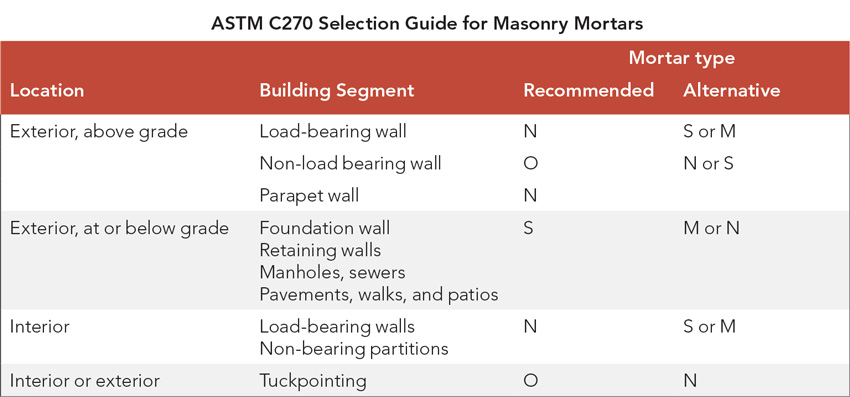
Mortar Types and Strength
Regardless of the standard used or whether the property or proportion specification is selected, there are four types of mortar that are identified for building construction as follows:
- Type M: This mortar classification achieves the highest overall compressive strength based on the property specification of ASTM C270, with a minimum capacity of 2,500 pounds per square inch (psi). It also needs to contain a minimum of 75 percent water retention and a maximum air content of 12 percent. Note that type M mortar should only be used where higher than typical compressive strength is called for in load-bearing interior or exterior walls (below or above grade). Otherwise, type M should be avoided in situations where it isn’t required. This is consistent with the ASTM C270 statements: “Do not specify a higher-strength mortar than that required for the masonry unit and application” and “Do not substitute higher-strength mortar for weaker specified mortars.” The reasoning behind these statements is based on compatibility with the surrounding masonry. Masonry that is not under high levels of compression but has a mortar with high compression resistance capabilities may result in cracking or splitting of the masonry units (i.e., CMU, brick, etc.).
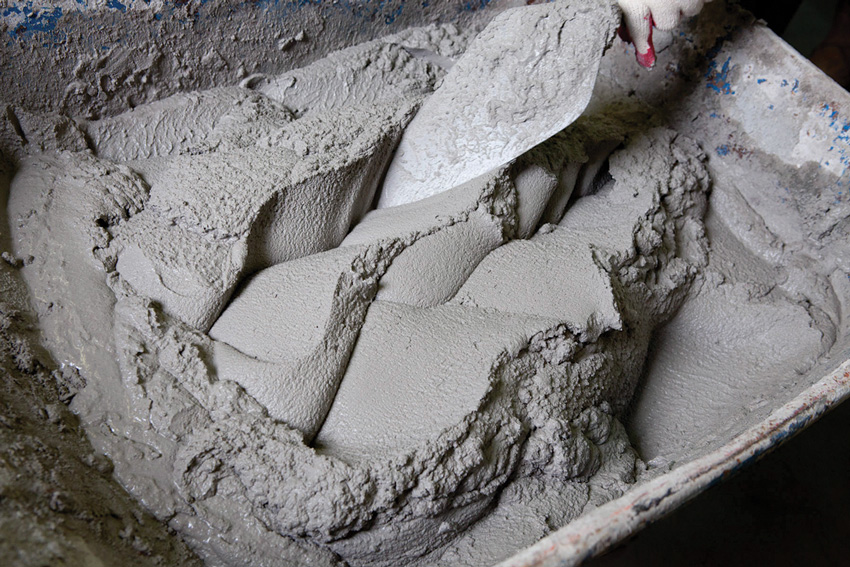
Using higher-strength mortar than called for in a wall can create structural problems in the adjacent masonry units.
- Type S: This is a standard but superior mortar classification with an ASTM C270 minimum compressive strength of 1,800 psi. It similarly needs to contain a minimum of 75 percent water retention and a maximum air content of 12 percent. Type S mortar is suitable for load-bearing exterior walls at or below grade, including foundation walls, retaining walls, pavements, walks, and patios. It could also be used as an alternative for load-bearing or non-load bearing interior or exterior walls above grade if structural requirements dictate it.
- Type N: This is a normal mortar classification with an ASTM C270 minimum compressive strength of 750 psi. Like the other mortars, it needs to contain a minimum of 75 percent water retention and a maximum air content of 12 percent if structural reinforcement is used—otherwise air content can increase to 14 percent. Type N mortar is suitable for above-grade load-bearing exterior walls and parapets as well as load-bearing interior walls. It could also be used as an alternative for most other masonry situations, such as non-load bearing interior walls, exterior walls below grade, or tuckpointing open joints when warranted.
- Type O: This is the lightest-duty mortar with an ASTM C270 minimum compressive strength of 350 psi. Like type N mortar, it needs to contain a minimum of 75 percent water retention and a maximum air content of 12 percent if structural reinforcement is used—otherwise air content can increase to 14 percent. Note that this is the same ratio for sand as for other mortar types, but since the overall amount of cement and lime mixture could be notably more, the actual quantity of sand could also be notably more. Type O mortar is recommended for light-duty applications, such as tuckpointing open joints or for non-load bearing interior walls.
Clearly, there are some notable differences between the different types of mortars in terms of properties, strength, and performance as well as good reasons to be sure the right formulation is selected and used for particular applications in a building. Since there are also choices in how they are blended it is easy to see how the potential for error exists if the wrong proportions are used or if they are transposed between different types of cement.
Mortar Makeup
The basic formulation and mixing of mortar creates a man-made product using a combination of mostly natural ingredients. Among the most significant factors that contribute to making a good mortar is the quality of the individual ingredients. Therefore, separate from standards for the mortar, the industry has developed standards that identify quantifiable specifications relevant to each item used in mortar. These ingredients include those listed as follows:
- Cement: This is essentially the paste that provides basic structural adhesion to hold the other ingredients together. Of course, cement is just one ingredient of mortar and is usually a manufactured product produced independently of the mortar. It is typically formulated through a controlled chemical combination of calcium, silicon, aluminum, iron, and other basic elements. When these ingredients are heated at high temperatures, they form a rock-like substance called clinker that is then ground into very fine cement powder. When it comes to the specific type of cement used in mortar, there are two common choices, which vary by the ratio of their mix of cement ingredients and the resulting properties.

Masonry mortar and all of its ingredients contribute to all types of buildings of all sizes.
- Portland cement is categorized into 10 different types based on specific properties as identified in ASTM C 150: Standard Specification for Portland Cement. While portland cement is used in general concrete and masonry construction for a variety of purposes, it is also commonly used as the cement ingredient for masonry mortar. To be effective in this use, additional lime is typically called for in addition to the lime already in the portland cement.
- Masonry cement is quite specifically formulated for masonry construction and is classified as type M, S, or N, according to the prescribed physical requirements of ASTM C 91: Standard Specification for Masonry Cement for the type specified. Under this standard, masonry cement shall conform to prescribed requirements, such as fineness, autoclave expansion, time of setting, compressive strength, flexural bond strength, air content of mortar, and water retention. In general, the cement type should be used to match the mortar type, such as type M or S masonry cement being used to create type M or S mortar, respectively. Type N masonry cement is used for either type N or type O mortar. Since masonry cement has higher contents of lime than portland cement, there is no need to add additional lime when mixing it in mortar.
- Hydrated lime: This ingredient, although already present in the cement, may be added to portland cement to further promote the chemical hydration process of the mortar and improve workability, water retention, and overall strength. Hydrated lime, whether used solely in the cement or added to the mortar mix, is subject to ASTM C207: Standard Specification for Hydrated Lime for Masonry Purposes, which identifies four different types of lime suitable to different masonry conditions.
- Masonry sand: This is the fine aggregate in the mortar that is often called the backbone of mortar. It provides bulk and body for the mortar, while also contributing directly to the overall yield of the mortar mix. This is because anywhere between two-and-a-fourth to six times the quantities of sand is used by proportion compared to the cement and lime in different mortar mixes. From a functional standpoint, it contributes directly to the strength and shrink resistance of the mortar. Because of its key role, masonry sand is subject to the very specific ASTM C144: Standard Specification for Aggregate for Masonry Mortar. This specification covers all aggregate types for use in masonry mortar, which is specifically limited to natural sand or manufactured sand. Manufactured sand is produced from crushing stone, gravel, or air-cooled iron blast-furnace slag that has been specially processed to ensure suitable gradation. The standard requires that the selected sand aggregate must be graded within prescribed limits. Further, the amount of deleterious foreign substances in aggregate for masonry mortar is limited within those grading standards. The sand aggregate is also subject to five cycles of a soundness test, a density test, and a calculation of the air content of the mortars where the sand is used.
- Potable water: As a combination of hydrogen and oxygen, water is needed to allow chemical hydration to occur in the mortar. This is not a matter of water as a mixing agent that then evaporates away but a true chemical reaction that creates the bonding of materials, particularly within the cement and lime. In other words, this chemical hydration is what transforms the dry mix of separate ingredients into a single, solid mass. Because of its critical chemical role, the standard specification for water requires it to be of potable quality suitable for drinking and free of impurities.
- Air: Inherent in the process of mixing anything, air is commonly trapped in the form of bubbles of various shapes. That is ok for mortar as long as it is controlled so it doesn’t affect the other properties of the mortar. The amount of air is governed or impacted by different ASTM standards related to the cement, the sand, or the overall mortar mix.
- Admixtures: These are chemical or natural additives introduced to the mortar mix to promote particular characteristics either for performance, such as added strength or water resistance, for workability, such as increasing set time, or for appearance, such as color. Most admixtures need to demonstrate that they do not compromise any of the other capabilities and characteristics of the mortar.
Clearly, there is a lot of information, testing standards, and knowledge on each of the ingredients of mortar, which require some skill and understanding to be sure that each ingredient is appropriate, high quality, and suited to its intended use.
Mortar Mixing
Once the ingredients are assembled to produce the needed mortar types for a particular project, the fundamental choice is whether to then mix the mortar on-site from separate ingredients or to use pre-blended (i.e., factory dry-mixed) mortar that is delivered in bulk to the job-site. Let’s take a closer look at each process as follows.
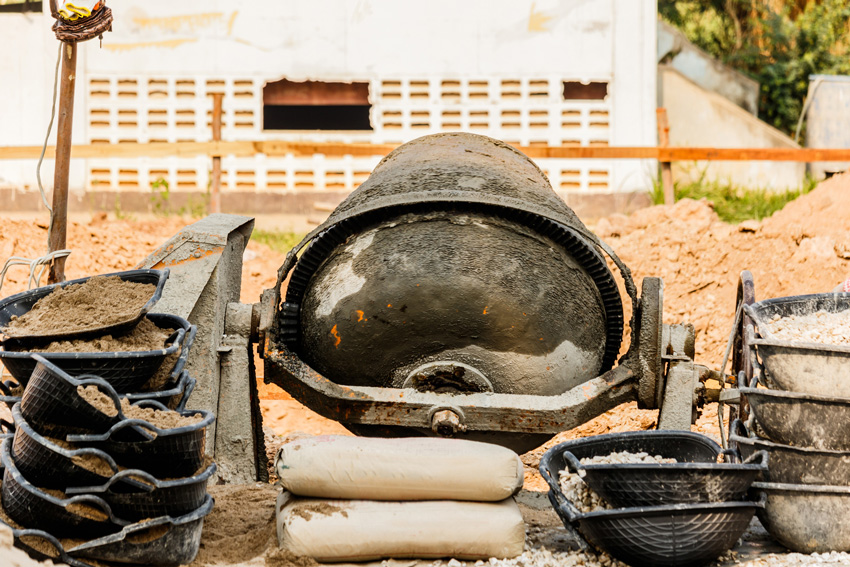
Site mixing involves bulk sand and bags of cementitious materials being blended by proportions in a job-site mixer.
Site Mixing
While mixing on-site has been the norm for centuries, modern times present some significant challenges in terms of quality control. We are no longer in the historical era that was dominated by generational succession of masons with knowledge transferred and skills developed over a lifetime. Instead, we find ourselves in a time with a well-publicized shortage of skilled trade workers who not only understand the technical aspects of their trade but, just as importantly, have the experience to provide intuitive judgement to know when things are right or not. At the same time, the standards and specifications for the ingredients and the mixing of mortar have become increasingly more sophisticated and refined, particularly as new advances in masonry design and construction in general have occurred. This puts a lot of intellectual pressure on the people at the job-site who are tasked with mixing the mortar all day long, not to mention the physical strain of lifting and shoveling the sand, cement, and lime in both dry and mixed (wet) forms.
Beyond the labor challenges of site mixing, one of the biggest material challenges is maintaining the quality of the masonry sand. Commonly, this is delivered to the site by the truckload and dumped on the ground next to an on-site mixer. Cement and lime are commonly delivered in paper/plastic packaging or bags, which protect them from both contamination and moisture. But since, as we’ve seen, anywhere from two-and-a-fouth to six times more sand is needed than the cementitious products, and since it is usually a locally quarried product, bulk truck delivery has been the norm. The problem is that this bulk sand is stored outside, on the ground with variable protection, which can range from open exposure to a tarp over the sand pile to maybe a partial temporary roof. If the sand gets wet, either from capillary absorption from the ground, from rainwater, or from condensation due to humidity in the air, it can have a direct and detrimental impact on the mixing process. Water is added during the mixing process based on prescribed ratios just like the dry ingredients. If the sand is already wet, however, it is nearly impossible to accurately determine how much water is already in it. It is also likely that water is not potable, meaning that there are impurities and even chemical contaminants in it. As a result, the person mixing the mortar on-site either uses the prescribed amount of water for dry sand mixing or has to guess how to adjust the amount of water. Neither one is likely to produce a mortar mix that is closely calibrated to the ASTM C 270 standard. Further, the unknown contaminants in the water can affect the chemical hydration of the mortar and the qualities of some admixtures.
This contamination of the sand is referred to as sand bulking. Beyond water infiltration or contamination, it can also occur if solids other than sand get mixed in. That could include dirt from the site that is either inadvertently shoveled up with the sand or blown in the form of job-site dust onto the sand pile. It could also include debris, saw dust, or other common job-site materials that may not affect other trades but can be a significant problem for masons. This sand bulking is the condition that everyone wants to avoid because of the potential problems it can create for the finished building. Since the mortar-mixing process is based on engineering and physical science properties, any contaminants or changes in the ratio of materials changes the characteristics of the mortar. That may first be seen by the masons using the contaminated mortar who recognize a change in the workability of it and try to compensate with additional hand mixing or quick fixes to keep going, or just give up and discard it as a bad batch.
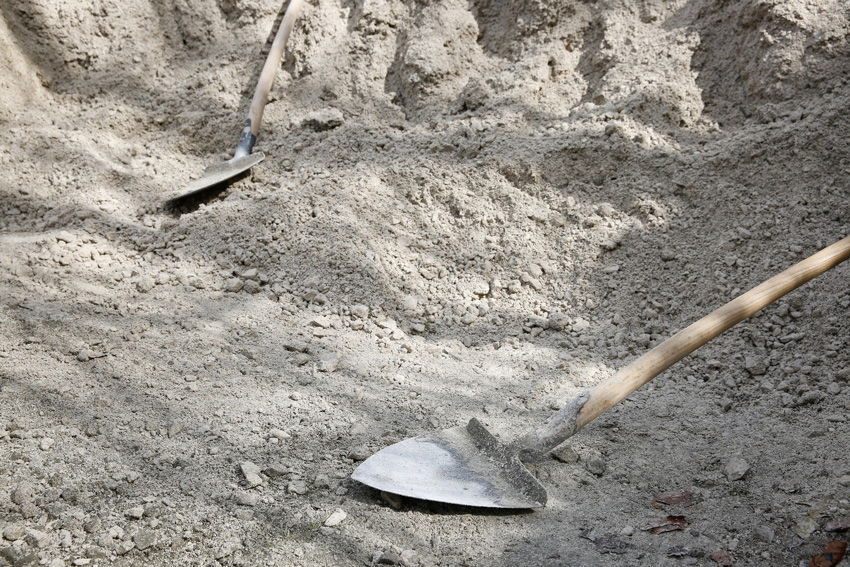
Sand bulking is a serious concern that occurs when water or contaminants make their way into the masonry sand and ultimately the mortar.
Sand bulking can also cause problems with the strength and psi ratings of the mortar. Under ASTM C270, testing of the mortar is called for in a laboratory. However, there is also a need to verify the performance of site-mixed mortar using ASTM C780: Standard Test Method for Preconstruction and Construction Evaluation of Mortars for Plain and Reinforced Unit Masonry. Not surprisingly, there can be a difference from lab conditions and site conditions, which can create significant variations in results. These include the differences between field conditions and laboratory conditions, the difference between mortar in a test cube and an actual wall, or the inability to accurately replicate the contaminated conditions in a tested sample. Hence, while it is normally expected that the actual psi rating of mortar is higher than specified minimums, the contaminants can interfere with the initial compressive strength, the longer-term strength, or both. Even if the strength does meet minimums, the contaminants can cause other problems. For example, if soluble salts for example end up in the mortar, that could cause problems for reinforcing steel that is subject to corrosion from them. Other contaminants could cause chemical imbalances in the mortar such that problems show up later, such as efflorescence on the face of the finished masonry.
Pre-blended: Eliminating the Guesswork in the Mortar-Mixing Processes
Recognizing the multiple challenges of site-mixed mortar, it is not surprising that pre-blended mortar is so often specified and preferred. Under the controlled conditions of a factory setting, all of the ingredients for mortar can be much more precisely managed and blended to create much more predictable results based on the engineered standards of ASTM C270 and ASTM C1714.
The pre-blended process starts with protected storage of all of the ingredients, either in large silos or some similar permanent housing. The cement materials are stored separately from the lime and sand materials. In the case of the sand, it commonly comes from sources local to the blending plant, but it is fully graded and sorted accordingly. It is also subject to a drying process to achieve less than 1/2 percent moisture content. These precautions help eliminate any possibility of sand bulking or contamination of any kind, whether from water or solids.
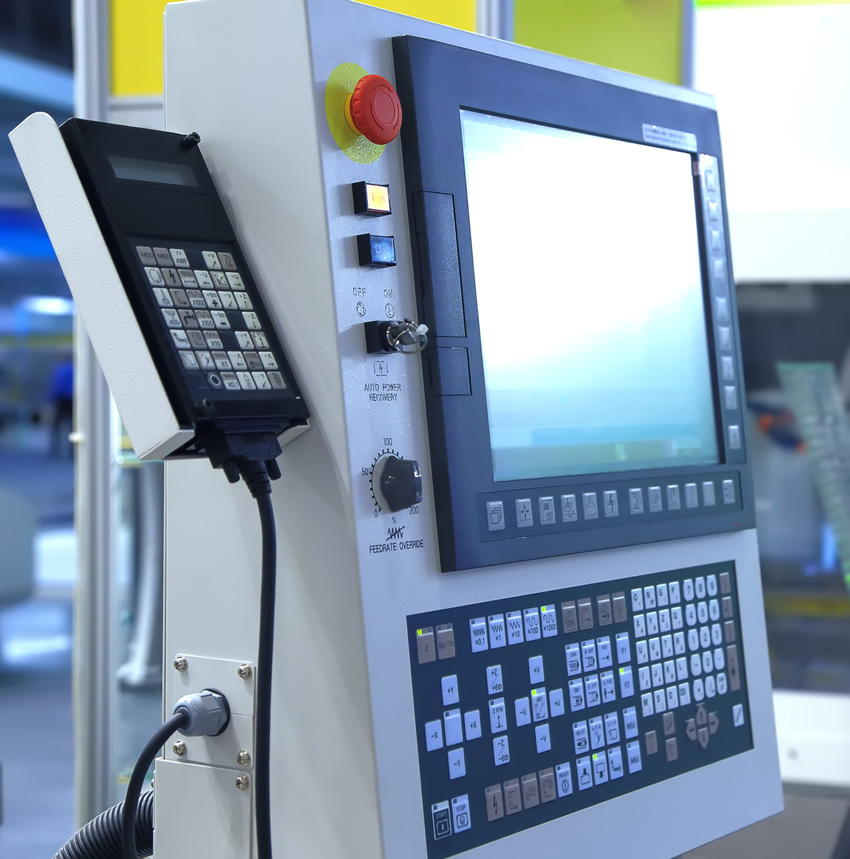
Pre-blending is a process that is carefully controlled by people and computers to assure consistent mortar quality.
The actual blending process begins by selecting the specific type of mortar being prepared (M, S, N, or O) paired with the appropriate type of cement (M, S, or N). The specified amounts of cement, lime as appropriate, and sand are each individually delivered into a hopper based on computer-regulated flows and measurements. In the hopper, each individual material is weighed for conformance with ASTM specifications. From the weighing hopper, all of the measured ingredients go into the mixer, where they can be completely blended for optimal consistency. When the batch is fully blended and examined, then it is released to a fill station for packaging. Manufacturers offer waterproof bulk packaging choices in sizes that range from 80 to 3,000 pounds. This allows it to be used economically on virtually all sizes of projects, whether a single-family residence, a masonry commercial building, or a large professional sports stadium. The bulk packaging of all ingredients also helps reduce the waste of multiple smaller bags of cement and lime so commonly seen on construction sites of masonry projects.
Once on the site, the mason contractor only needs to add the required amount of water to turn the dry pre-blend into a high-quality mortar directly suited to the application. This can be done in a conventional mixer that is fed by opening bags or from a portable silo if the job is large enough. This is a piece of equipment that can be rented like other construction equipment and used in conjunction with a standard forklift to function. In this case, the prepackaged, pre-blended mortar is loaded from the top and dispensed as needed into a standard mixer that can be located beneath it. Then a controlled amount of water is added as it turns, and the resulting mortar can be loaded into conventional delivery equipment, such as wheelbarrow, hoses, etc. The whole process is faster, much more controlled, leaves almost nothing to chance, and is better for the safety and ergonomics of the workers involved. It should be noted that, in recent times, there has been some concern about silica and cement dust being released into the air around any mixing operation. With the silo approach, it is easier to contain and control any such release and protect workers.
Overall, pre-blended mortar has been shown to provide greater quality control with much higher consistency than site-mixed mortar. For masons, it provides increased workability, more ergonomic process, and allows them to work with a local pre-blended specialist rather than need to be skilled in all areas of mortar. For architects and owners, it reduces the potential for improper or contaminated mortar mixes that can lead to structural issues, efflorescence, or other problems. According to Garen Graves, a pre-blended mortar specialist with Echelon/Oldcastle, “If there’s a problem with a given wall structure, architects can call the manufacturer. Pre-blended usage eliminates the finger pointing common with a warranty or failure claim. Rather than hunting down the field mixer, which is often impossible given the nature of the job, the architect has documented evidence that the wall used a certified, code-approved mortar and quickly eliminates one cause for failure.”
Admixtures
In addition to the basic ingredients of mortar, a variety of admixtures can be introduced to create specific variations and results. Since admixtures often have much more precise measurement and mixing requirements, it is easy to see why adding them in a pre-blended process makes much more sense than a site-mixing process. A common admixture is the use of a coloring agent or pigment to make the mortar blend with or contrast against the color of the surrounding masonry. Such coloring in the field is subject to all of the same limitations and challenges as the rest of the site mixing, whereas factory blending allows for complete color consistency throughout the mortar.

An on-site silo can be used with a forklift and on-site mixer to portion out mortar as needed to mix with controlled amounts of water.
Some admixtures are only available in pre-blended mortar products. One such example is a water-repellent additive that is based on engineered polymers and materials science. If a masonry wall doesn’t properly resist water and moisture, that doesn’t bode well for creating a weather-tight building enclosure or protecting the long-term durability of an exterior wall. In some cases, the walls, including the mortar, have been covered over with sealants or paint to keep the water out. However, that solution requires ongoing maintenance and may not produce the best results over time. An alternative is to use an engineered admixture in both the CMU and the mortar to give it the water-repellent properties that are sought. This approach provides continuous moisture protection with fully integrated water-repellent technologies that are factory engineered into both the masonry and mortar. Manufacturers point out that this forms a continuous shield against wind-driven rain for the life of the building, without impacting aesthetics or installation ease. Because it can come pre-blended into the mortar and the CMU, it’s easy to source, easy to verify, and as easy to install as traditional architectural block or veneer and mortar.

Admixtures, such as pigments for colored mortar, can be added to both site-mixed or pre-blended mortar, although more consistent results are typically found in pre-blended.
Specifying Pre-Blended Mortar
In general, it should be clear by now that mortar is critical to a masonry wall’s structural integrity and aesthetic value. Therefore, specifications for it must be based on good information, and quality assurance tests must be applied correctly. Architects writing specifications for mortar need to be aware of the differences and specific capabilities of the different mortar types, making good spec writing critically important. Under the MasterFormat specification standard, masonry mortar is normally including in Section 04 05 13 or related sections.
Under Part 1: General of a standard three-part specification, the performance standards should be listed, including ASTM C270 and ASTM C1714, for the mortar and whether property specifications need to be followed or if proportion specifications will be acceptable. Also list the relevant standards for each ingredient and any relevant details related to them. This is a case where it makes sense to always request a complete submittal package so the materials, colors, and any admixtures can be fully inspected and confirmed. It also makes sense to request that a sample or test panel be constructed to see the product on the site before it is incorporated fully into the project. Be sure to call for it to be washed and cured for seven days on-site before being evaluated. As part of the quality assurance of the mortar, distinguish between on-site testing and material testing in a laboratory and request laboratory-certified test results. Verify that the same materials used in the test panel are the ones that were specified and tested.
Under Part 2: Products, there should be reference to a masonry schedule or other information on the drawings if multiple types of masonry construction and mortar are being used so the locations are clear. The specification should then go on to provide the details of each of the scheduled or identified products. If pre-blended mortar is being specified, then it should be clearly stated along with any restrictions against site-mixed mortar. Either way, identify each type of mortar needed (M, S, N, O) and where each is called for. If colored mortars are being used, then the specific colors need to be identified. Overall, specify consistent mortar materials, pigments, and mixing procedures.
In terms of Part 3: Installation Requirements, proper handling of all mortar materials on-site, whether pre-blended or otherwise, needs to be emphasized. If the mortar is pre-blended, then no instructions need to be given related to mixing other than the means of adding water. Final placing, protecting, and cleaning in a manner consistent with PCA and other approved standards or methodology will round out the specification.

The back side of CMU and mortar treated with an admixture to improve water repellency is shown on the left compared to CMU and mortar without the admixture on the right. Both were sprayed with water on the front side, and after a short time, the difference in water repellency was clearly evident.
Conclusion
With an understanding of the importance of masonry mortar and the clear advantages of pre-blended mortar, the final question isn’t why would you use it on your projects, but rather, why wouldn’t you specify pre-blended mortar? The structural integrity of the mortar is easier to assure, and the aesthetic values are more controllable. Pre-blending provides better quality control and consistency with full technical support available from manufacturers. Further, it produces less waste and can improve job-site safety for workers.
Peter J. Arsenault, FAIA, NCARB, LEED AP, is a practicing architect, green building consultant, continuing education presenter, and prolific author engaged nationwide in advancing building performance through better design. www.linkedin.com/in/pjaarch

|
Echelon is the consolidated brand for all masonry products and services of Oldcastle Architectural, including Trenwyth® architectural masonry, artisan masonry stone veneers®, Quik-Brik® concrete masonry units, Amerimix® gagged goods, and a complete portfolio of performance upgrades. As a single-source masonry portfolio solution, Echelon delivers consistent, reliable product manufactured locally at more than 170 locations and delivered by an unrivaled logistics network. For more information, call 844-495-8211 or visit www.echelonmasonry.com. |


